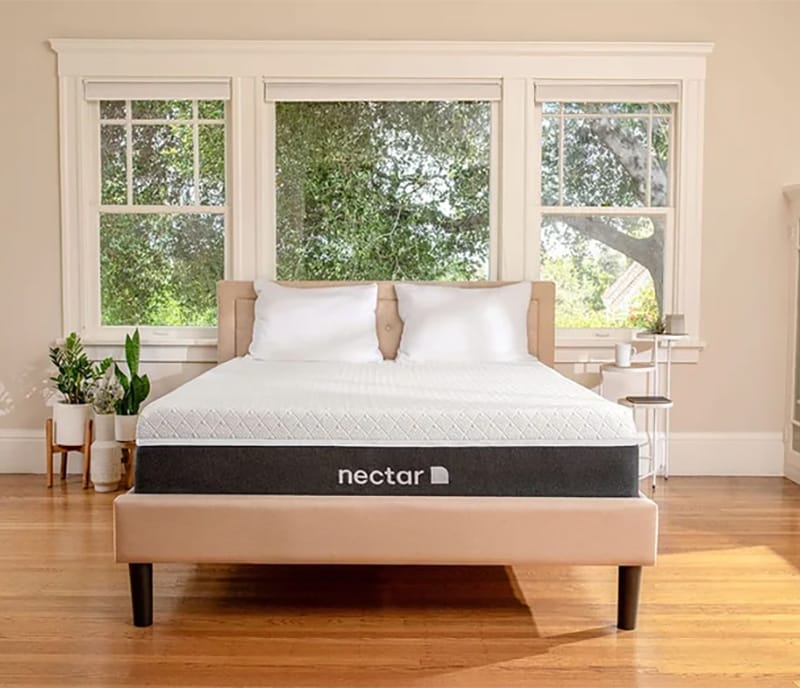Quilted Cool Cover
Conk out cool with this soft, breathable poly-blend cover featuring heat wicking, cooling technology.
Nectar Smart Layer with ActiveCool HD
Zonk out in a temperature-responsive oasis, with a 3-inch layer of gel-infused memory foam with phase-change material. (Designed in labs to react to your rising and dropping body temperatures, auto-adjusting to your temperature as you sleep.)
Dynamic Support Layer
Get tailored bounce-back with 2 inches of dynamically adjusting foam. Get the support your body needs to relax into a deep sleep.
Stay-Stable Base layer
This sturdy 7-inch layer of standard foam ensures the comfort and support layers above it perform at their best.
Shift-Resistant Lower Cover
No slip-and-slide here. Your mattress stays together, no matter how much you jump on it.
Zonk Out Cold With Breathable Cooling Action.
Never sleep in a sauna again (unless it’s intentional). A sleep-tech-infused, cool-to-the-touch quilted breathable cover helps keep your sleeping temp regulated.
Slumber Comfy With Minimal Motion Transfer.
Move around freely without waking your partner or spilling your drink. Gel-infused memory foam gently cradles you to sleep and keeps you there, with a snug-as-a-bug body hug.






by Jay
Extremely comfortable. Soft but with good support. Would definitely recommend this mattress to anyone!
by Jennifer
I have a lower back, hip and knee pain due to osteoarthritis. This mattress helped me a lot. It is just right, not too hard and not too soft. I need it hard so get my back straight yet soft for comfort. The memory foam on the top contours to my body. Love it!
by Wayne
It is so comfortable and warm.
by Taylor
Our first bed-in-a-box and we couldn’t be happier. My wife wasn’t too sure the first few nights but as our bodies got more used to the feel and the mattress conformed to our bodies, we started sleeping much better. We’re over a month now and are stoked ever night when we get a chance to go to bed, and feel well rested in the morning!
by Jamie
Bought this mattress because our old one needed to be replaced. My hip and shoulders were always hurting and my husband had back and shoulder pain. After about a week on this mattress both of our pain is gone. We love this mattress.
by Victoria
My partner and I love this mattress. We weren’t sure if we should splurge on it, but we’re glad we did. My sister, who is a stressed out grad student, just discovered she had bed bugs in her apartment, so she’s been crashing at my place while they treat her unit. She said she gets the best night’s sleep on this mattress and is now convinced she needs a Nectar to help her stay awake and feel refreshed with her 7 am to 7 pm work/class schedule.
by Braya
Having herniated dicks in my neck and back it is hard to find a good mattress that works. I’ve had it a little over a month and sleep well every night. I like that it doesn’t heat up like my old Sealy Optimum did. It works well being a side sleeper. It’s rare when I get a full nights sleep. This bed has changed the game for me. Thanks Nectar for making an awesome product.
by Kinshasha
Great mattress overall! Replaced old pillow top mattress with Nectar Premium mattress. Happy that I upgraded!
by Andrea
When I was researching brands for a new and bigger bed for my husband and I, most people told me to go with Nectar. I did some more research on my own and realized very quickly that Nectar had a lot to offer. I weighed the options, and ultimately, Nectar was the best price and quality. We went from a queen to a king and will never look back again. My husband is a very picky guy when it comes to mattresses and comfort, and this has blown him away. We are extremely pleased and now I’m telling everyone about Nectar when they ask about bed recommendations.